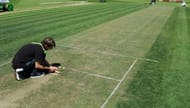D
Dead ball: A delivery on which no runs can be scored.
Deep: The playing area near the boundary ropes.
Defence: The batsman's technique in stopping the ball.
Delivery: The act of bowling the ball.
Doosra: The off spinner's version of the googly, delivered out of the back of the hand and turning away from the right-hander.
Drive: A stroke aimed at the pitch of the ball.
Duck: A score of 0.
Duckworth Lewis: A devised system to help decide one-day cricket matches when rain interrupts play. It is named after Frank Duckworth and Tony Lewis, two mathematicians.
E
Extras: The runs which are added to the side's total but which are not credited to any batsman or a bowler. Extras comprise of byes, leg-byes, wides and no-balls.
F
Finger-spin: A method of making the ball turn through finger movements.
Flipper: A leg-spinner's delivery that appears to be pitching short but skids on quickly and often results in bowed or lbw.
Full toss: A delivery that reaches the batsman without bouncing on the pitch.
Follow-through: The path of a bowler after the act of delivering the ball.
Forward stroke: A shot played by advancing the front foot down the wicket.
G
Gardening: The act of repairing or flattening the pitch with the bat.
Glance: A deflection of the ball off the face of the bat usually stroked to fine leg position.
Good length: A bowling length which puts a batsman in two minds as whether to play forward or back.
Greasy: A pitch of outfield affected by continuous showers.
Green-top: A well-grassed pitch. It retains the overnight moisture early in the day's play, and it favours the fast bowlers.
Googly: An off-break bowled with a leg-break action.
Grub: A ball bowled under-arm along the ground, it hardly bounces.
Gully: A close catching position on the off-side between the slips and the point region.
H
Half-volley: A ball that is over-pitched.
Handled the ball: Either batsman can be given out if he touches the ball with his hands while it is in play. The wicket is not credited to the bowler.
Hat-trick: The feat of taking three wickets with three consecutive balls within the same match by a bowler.
Hit the ball twice: The batsman is given out if he hits the ball twice except for the sole purpose defending his wicket. The wicket is not credited to the bowler.
Hit-wicket: The batsman is given out if he breaks his wickets with any part of his body, dress or bat when the ball is in play. The dismissal is credited to the bowler. He is not given out when trying to avoid run-out or stumped.
Hook: The shot made off the back-foot by which the short ball is directed to the leg-side.
I
In-swinger: A ball which moves in flight from off to leg.
K
King pair: A batsman bags a 'king pair' if he gets out on zero in both innings on the first ball.
L
LBW: The abbreviated form of Leg before wicket, a method of dismissal.
Leg-break: A ball that turns from leg to off after pitching.
Leg-cutter: A fast leg-break bowled by cutting the fingers across the seam of the ball.
Leg-side: The side of the pitch and field behind the batsman.
Leg theory: When a bowler continuously bowls on the leg stump and the batsman’s pads with fielders in catching position.
Length: An area where the ball pitches down the wicket.
Long handle: The term derives from the batsman's grip where he moves his hands to the top of the handle so that he can increase the arc of the swing.
Long-leg: Fielding position near the boundary behind the wicket on the leg-side.
Long-off and Long-on: Fielding position near the boundary on either side of the sightscreen.
M
Maiden: An over from which no runs are scored by the batsman.
Mankad: When the bowler brings his arm round and, instead of delivering the ball, runs out the non-striker batsman by dismissing off the bails. Usually, a warning is given to the batsman beforehand. The dismissal was named after India's Vinoo Mankad who twice dismissed the Australian Bill Brown in this manner.
N
Night watchman: A lower order batsman sent in to play out time when a wicket falls shortly before close of play. Usually, the night-watchman is sent to prevent better batsman's wicket.
No-ball: An illegal delivery, usually when the bowler overstepped the popping crease before releasing the ball.
Follow IPL Auction 2025 Live Updates, News & Biddings at Sportskeeda. Get the fastest updates on Mega-Auction and cricket news

